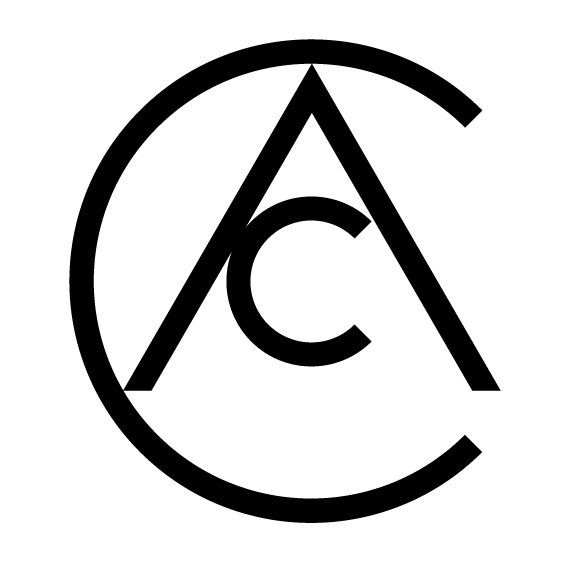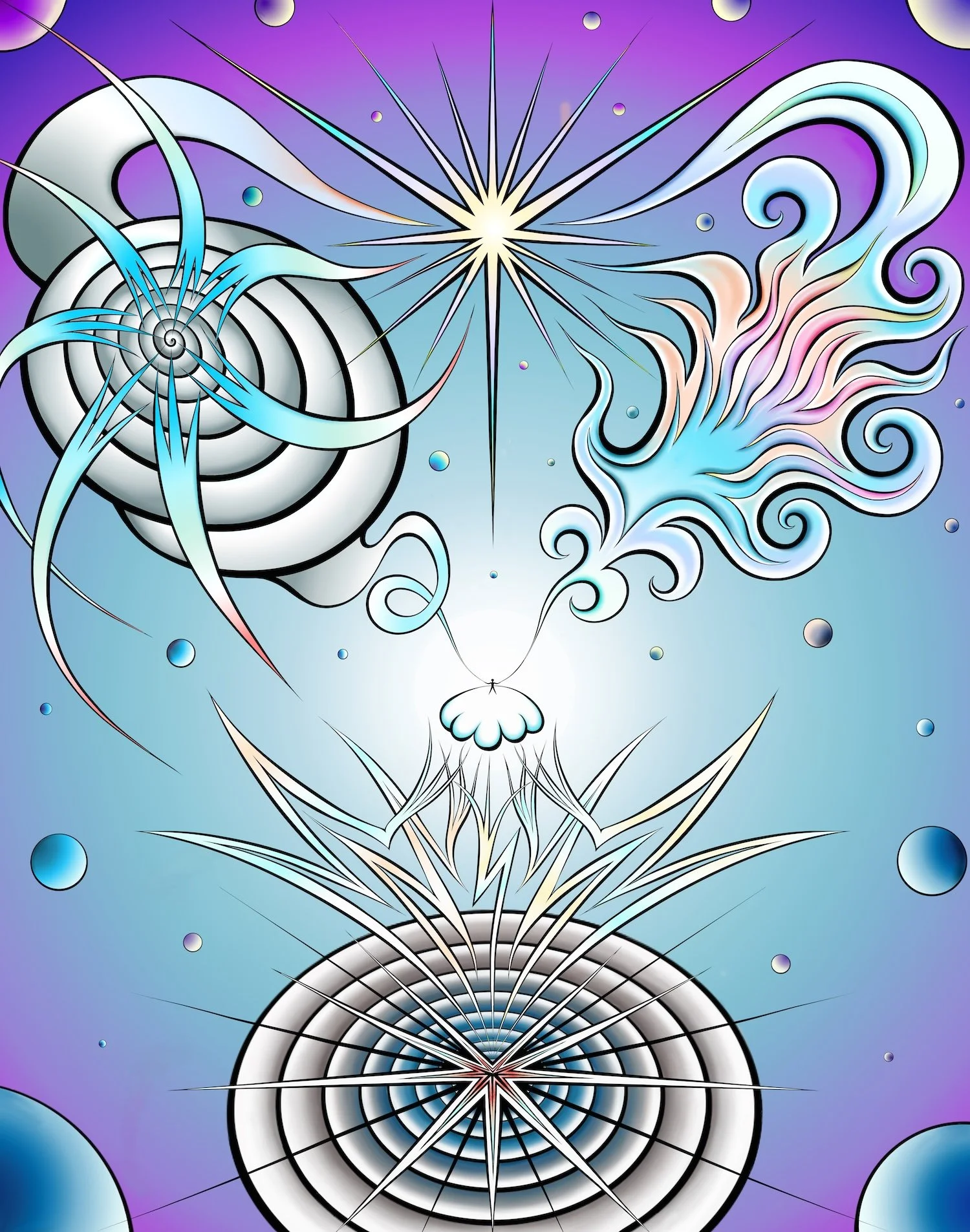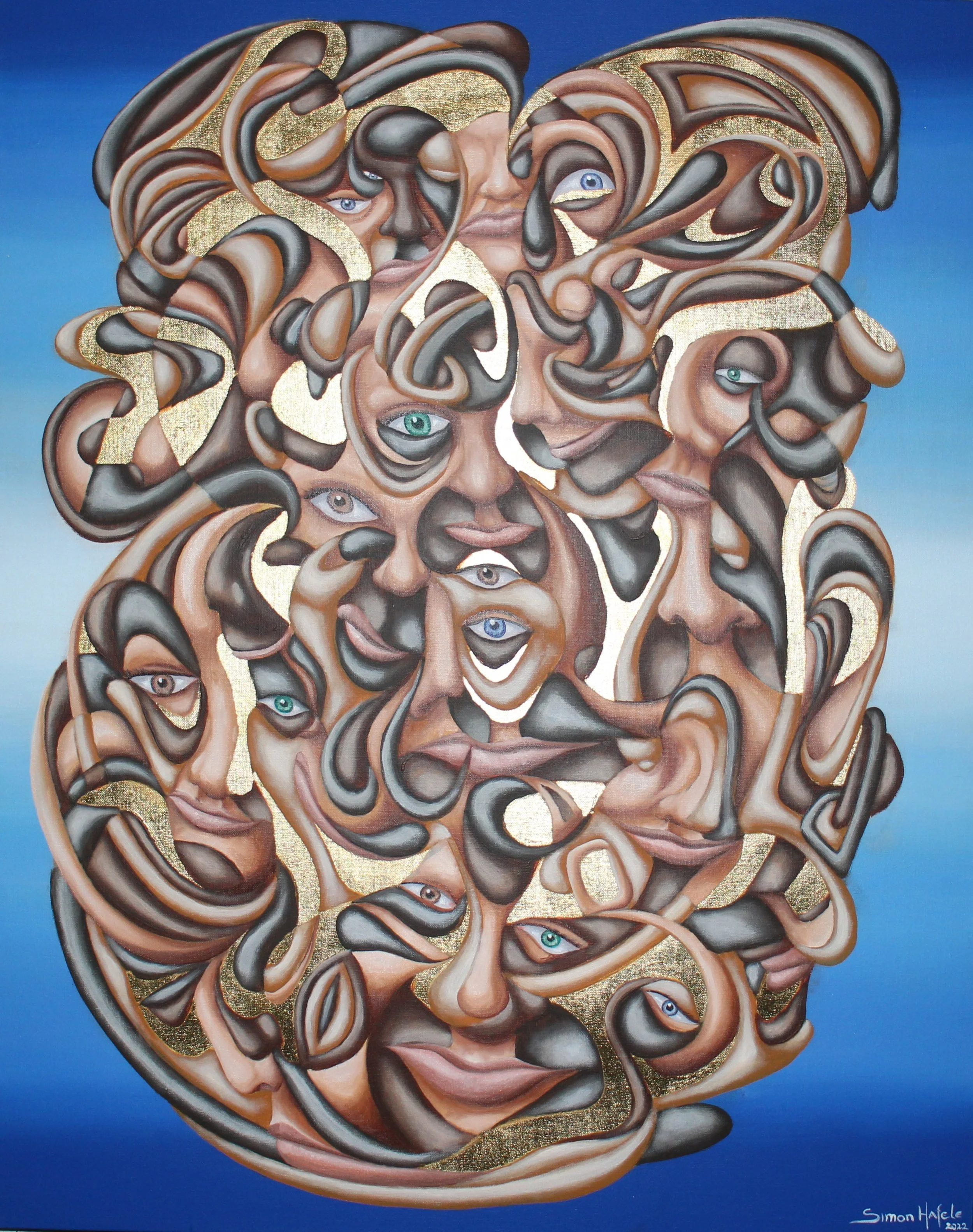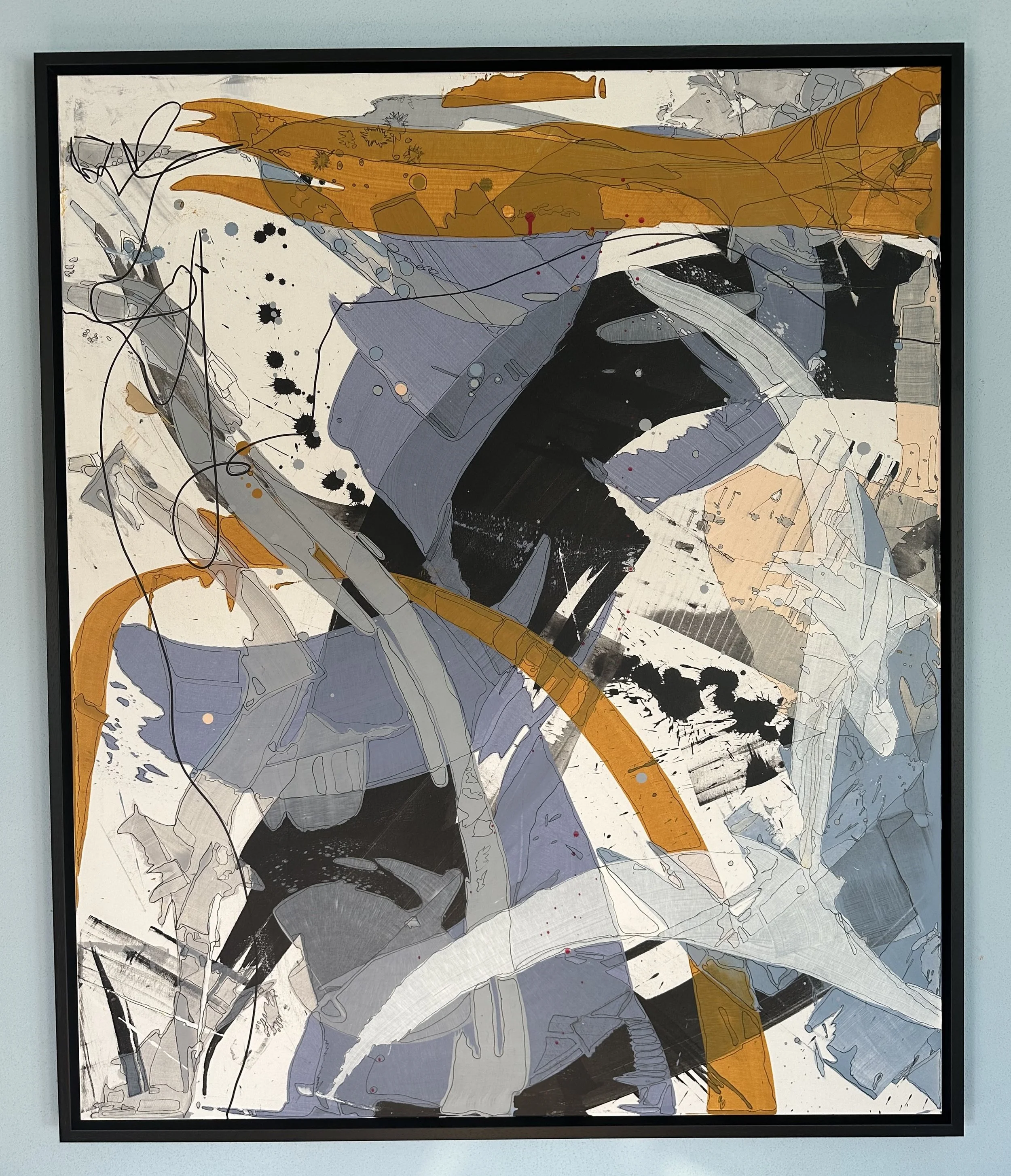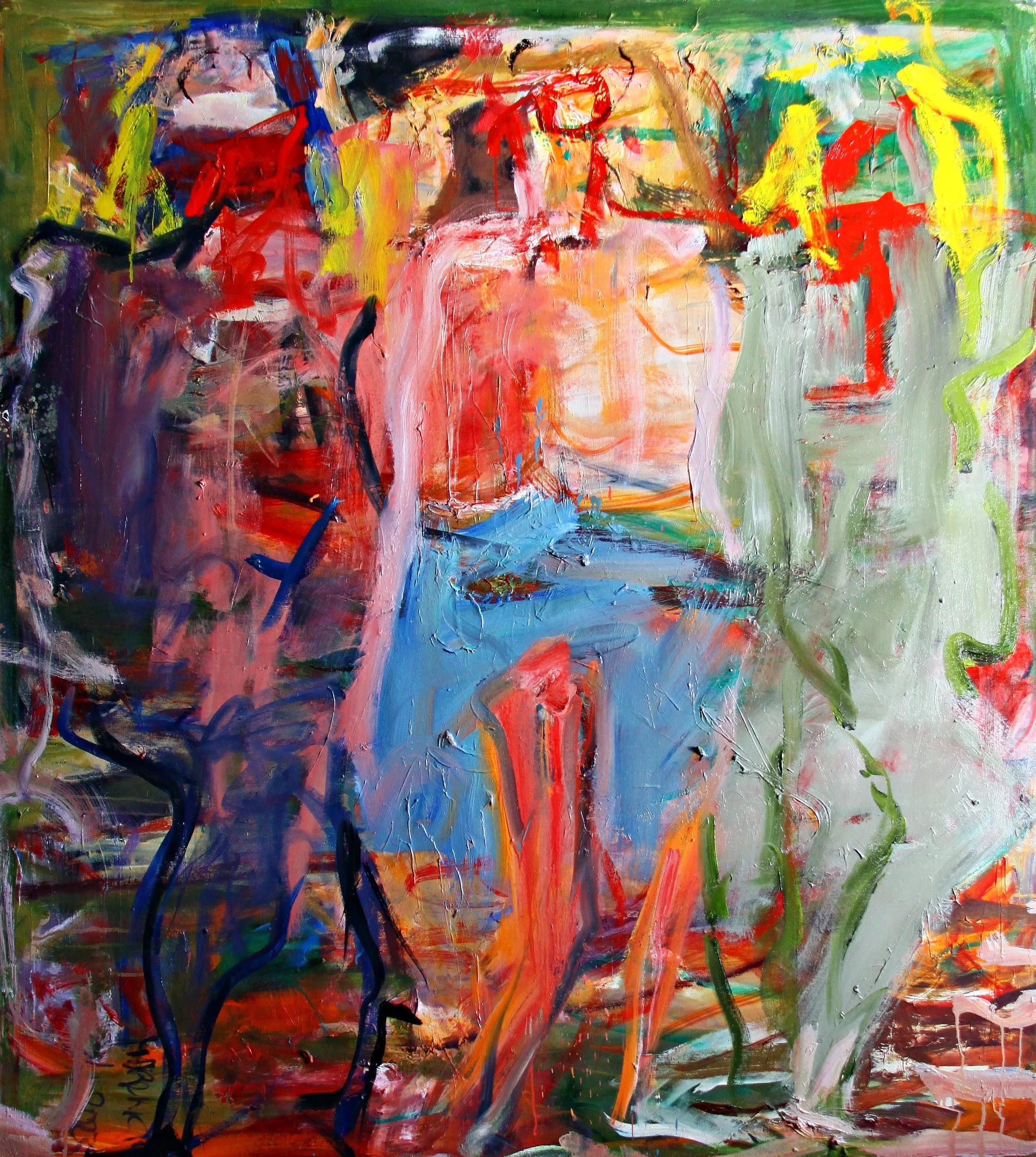I'm an autodidact when it comes to LIFE in general. I'm curious and eager to discover, and reducing myself to an academic approach doesn't suit me. I've evolved with courage, hard work and passion, over the course of my life as a woman artist, giving myself the freedom to create my own writing and offering myself the challenge of not resembling anyone by not locking myself into an academicism or fashion. At the start of my career, this may have seemed inconsistent to art professionals, but over time it has become an asset of authenticity.
All in Painting
Kathy Stanley
In the realm of contemporary art, Kathy Stanley emerges as a profound conduit for the thematic interplay between ecopsychology and the rising feminine spirit. Her oeuvre, deeply rooted in the rich soil of her Jamaican heritage and nurtured by the diverse landscapes of the Cascadia Bioregion, embodies an intuitive dance between mixed media and acrylics, manifesting as visual hymns to the Earth's magnificence and spiritual wisdom.
Matei Vogel
Matei Vogel's oeuvre, upon contemplation, evokes a visceral response that stands as a testament to his profound understanding of abstract art's capacity to resonate on an intuitive level, much like the universal language of music. Vogel's approach to painting, with its deliberate eschewing of representational fidelity, aligns him with the philosophical musings of Kandinsky and the expressive force of Abstract Expressionists like Rothko and Pollock. However, Vogel's work carves a unique niche, characterized by a palpable tension between the visible and the invisible, the known and the unknowable, resonating with the emotive power of music.
Interview with Teresa Bellini
Since 2018, Teresa has attended painting classes in Padua. During the 2020 lockdown, she experienced an intense creative period that led her to consider painting as an essential part of her life. She participated in group exhibitions in Italy, Europe, and the United States, and she exhibited her artworks in two solo exhibitions in Italy. Three Galleries in New York represent her.
Sabrina Villaseñor
Sabrina Villaseñor emerges as an artist whose work is a contemporary homage to the rich tapestry of pre-Hispanic culture, weaving its ancient symbols, figures, and forms into the modern fabric of fine art. Her paintings are visual narratives that speak of a profound search for cultural identity and heritage, bringing to life the ineffable voices of a past that refuses to be silenced by the progression of time.
Petra Mattes
The oeuvre of Petra Mattes represents a bold and dynamic foray into the realms of contemporary abstraction, a genre that continues to evolve and challenge the perceptive boundaries of its audience. Her work, characterized by the emotive use of color, gestural brushstrokes, and a profound sense of movement, seems to marry the intensity of Neo-Expressionism with the unrestrained freedom of Abstract Expressionism, creating a new species of abstraction that stands out in the modern art landscape.
Helen Kagan
In the contemporary art scene, Kagan's paintings are a beacon of emotional and spiritual depth. In a world often dominated by irony and detachment, her sincerity and commitment to healing through art stand out. She offers a counter-narrative to the prevailing trends, one that embraces the transformative power of art to affect change on a personal and collective level.
Interview with Edward Bakst
Can you share your journey towards becoming a successful artist? Were there any pivotal moments or challenges that shaped your career?
For me, life in general offered both challenges as well as inspiration motivating my strive forth, inspiring ideas and need for expressing and sharing my personal and emotional expressions. I deem that growing under Communism sparked strong rebellious reactions against feeling of oppression and lack of freedom of speech. My artwork of that period was very defiant. Yet, once a wave of antisemitism swept my former country, these feelings intensified. A new sense of pride in who I am arouse. It further intensified when I found myself being chased by many of my own classmates, now former friends, whose eyes and minds were soiled by governmental propaganda. Rebelling against being seen as less equal, I chose to resign my citizenship, becoming a political refugee, departing as both stateless as well as a persona non grata.
Interview with Simon Hafele
Reflecting on the evolution of my artistic style, the trajectory of my work can be traced back to the initial inklings seen in the graduation poster I designed for the Elbigenalp carving school. The naivety of my 18-year-old self manifested in those early creations. Subsequent journeys to India acted as a catalyst, lifting the fog and providing clarity to my artistic vision. Over the years, my perspective has matured, resulting in refined brushstrokes and a clearer view of my artistic intent. While adhering to my fundamental approach in art, I have delved deeper into areas of interest, such as sacred geometry, Fibonacci sequences, and the philosophical and mythological underpinnings of symbols. These elements seamlessly integrate into my art, reinforcing my thematic focus on love, mysticism, and the supernatural—embodied by the motto "die to live."
Interview with Lone Bech
When people ask me how long did it take you to make this painting I use to answer that it took me a lifetime because I started late in life to paint my response to the world around me; the people who inspire me and the elements of life that touch me.
I work with charcoal, acrylic, watercolor, cold wax, oil and encaustic, the latter being a very exciting material. It is the earliest known form of paint. It was first used by the Greeks over 2,000 years ago. Encaustic paint is beeswax and pigments mixed with a little damar resin. The damar raises the melting point of the beeswax, hardens it and gives the paint its unique optical depth to my portraitures.
INTERVIEW WITH Simon Darling
My journey into the world of art is intricately woven with the influence of my mom and her innate creativity. From the very beginning, she provided a nurturing environment that encouraged exploration, imagination, and self-expression.
My mom, herself a creative soul, instilled in me a deep appreciation for the arts. Our home was filled with colors, textures, and a constant flow of creative energy. Whether it was her own artistic endeavors or exposing me to various forms of art, she cultivated an environment that fueled my curiosity and sparked my initial interest in the world of creativity.
Interview with IRIS
What has always fascinated me in my experiments with water is the elegance of the organic forms that form on the surfaces where I let the water flow over. This unique elegance is given by the accuracy of the contours and the uniqueness and complexity of the composition. Where water leaves its mark, something magical always happens. This happens even when I experiment with just a few splashes of water. No experiment is the same, each time there is something new that captivates. Over time, I have also used other liquid substances in their simple form or mixed with other substances in powder form like: melted wax, honey, milk, ink, melted sugar, oil, wine, liquid soap, fruit juices, water with flour, water with sand, water with ground coffee, very salty water, melted chocolate and many others.
Interview with Marcello Muiesan
How has your experience in different fields like football, military service, and the culinary influenced your approach to painting and graphic design?
My experience across varied fields such as football, military service, and culinary arts has profoundly influenced my approach to painting and graphic design. Working in diverse fields, even those unrelated to my primary occupation has significantly broadened my perspective. This has facilitated meaningful connections with individuals from disparate backgrounds and cultivated a meticulous eye for detail, crucial in driving my creativity. Furthermore, this multifaceted experience has allowed me to perceive the world from different vantage points, enabling me to capture its intrinsic beauty in my artistic pursuits.
Doncho Zahariev
Doncho Zahariev's paintings capture more than mere landscapes; they are vivid emotional landscapes, each a complex tapestry of feelings and moods rendered in color and form. The collection of artworks exemplifies the depth and diversity of Zahariev's artistic expression, inviting us into a world where emotion and environment are inseparably intertwined.
Interview with Emiko Aida
Emiko Aida was born in Tokyo, Japan and graduated from MA, Fine Art, The Tokyo University of Arts / MA Printmaking, Royal College of Art, UK. She is currently a painter, printmaker and mixed media artist living in London, UK. Her work is exhibited in the U.K., the U.S.A., Italy, China and Japan and in many private, public and corporate collections including the New York Public Library, USA, Guangdong Museum of Art, China, Ashmolean Museum, Oxford, UK and Victoria and Albert Museum, London, UK. She is a member of Royal Society of Painter–Printmakers, U.K.
Interview with Karine Grazia
Karine Grazia (b.1986) is a freelance artist who lives and works in Italy and Estonia. In 2011 she graduated with a degree in interior architecture. Karine paints abstracts with acrylics. When creating her work, it is important for her to take into account the interior where the order goes. She desires to create an ideal environment, where people would feel comfortable. A picture on the wall can create a completely new feeling in the room. Since she has studied interior architecture, this is where it is possible to combine the two parts. The result is exactly what she wants to achieve through art.
Interview with Merle Luhaäär
Merle Luhaäär is an internationally exhibiting experimental mixed media artist. She has graduated from Royal College of Art (2019, London, UK) with MA in fine arts and received her BA in fine arts at Kingston University London. Her art practice is underpinned by an interest in relationship between individual and society, micro- and macrocosm and relativity of reality. Themes are explored through variety of mixed mediums of painting, print, photography, installation, sculpture and moving image.
Gustavs Filipsons
Gustavs Filipsons emerges as an intriguing contemporary artist whose body of work presents a compelling case for the vitality of abstract painting in the contemporary art scene. His paintings are a testament to the enduring relevance of abstraction, displaying a profound grasp of texture, form, and the emotive power of color. Filipsons' artworks is an exploration of the abstract expressionism continuum, where each piece offers a unique narrative expressed through bold strokes, layered textures, and an arresting palette.
Interview with Maria Petrovskaya
Maria Petrovskaya is a NYC-based artist and curator. She is a graduate of the School of Visual Arts (NYC). Her works in painting and sculpture explore the human body, movement, color, the subconscious, and the surreal.
Her art and curatorial projects featuring emerging contemporary artists were listed as must-see by the Art Newspaper, LA Weekly, Hyperallergic, L’Officiel, and Whitewall Magazine, among others.
Interview with Maria Aparici
In Maria Aparici Vives’s work, one notes a distant but suggestive pictorial connection with her grand-uncle, Manuel Benedito Vives (1875-1963), a painter of the Valentian school, especially in her female portraits in which each artist articulates a certain concept of style in accordance with the nomenclatures and vicissitudes of his/her time. One might argue that what is in him an orthodox and sober characterization of bodies and atmospheres, Aparici’s work sets an expressionist and algid formulation of this same gender in boiling gestures, streaks, expressions and colors. They indicate an evolutionary tendency which leaves the eye with a creative vitalism in the times of different generations. Gregorio Vigil-Escalera (Spanish art critic).
